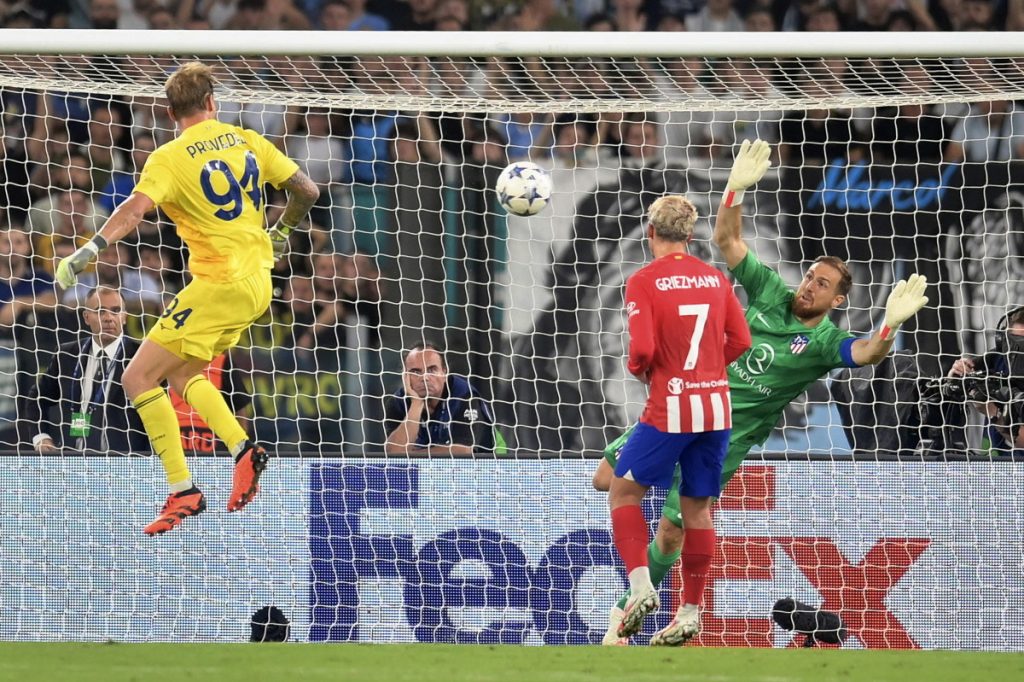
From goalkeepers scoring to the bight orange Adidas Tango in blizzard-like conditions, Nick Bruzon looks at some of football’s werider occurrences.
Matchweek six in the Premier League saw all manner of interest generated. At the top of the table, the juggernaut that is Manchester City showed no signs of anybody being able to stop it. A 2-0 defeat of Nottingham Forest was as regulation as they come, with the strangest thing for Pep’s team being a game played at 3pm on a Saturday, as they made it six wins out of six. At least the quadruple is off.
Liverpool and Brighton both won to remain in touching distance but it already has the feel of a long, hard season for anybody else with aspirations of winning the title.
Elsewhere, Luton Town are off the mark. A Carlton Morris equaliser from the spot in a 1-1 draw with Wolves was enough to earn The Hatters their first point of the season. They are now level with a Burnley side who went down 1-0 at home to Manchester United although both clubs can take comfort in not being bottom.
That somewhat dubious honour goes to Sheffield United who also have a solitary point but a goal difference of -12 after their opening six games. It is a figure largely caused by their own result at Bramall Lane on Sunday where Newcastle United stepped up a gear in some style.
The game was dead and buried at half-time as the visitors raced to a 3-0 lead. However, rather than sit back they pushed on. In the end, it finished 0-8, with the scoreline made all the more remarkable given each goal was scored by a different player.
Coincidentally, this sort of high-scoring fixture was something we mentioned in passing during last week’s column about the Champions League. It was referenced in a comment about the more ‘niche’ things that happen in the beautiful game so now seems an appropriate time to delve a little deeper. So what are the top five of football’s more unusual occurrences? Let’s have a look:
5: Match abandoned because of insufficient players remaining
Football is a game played between two teams of 11 players. It is one of the most basic rules of the game but at the same time, factors outside of a manager’s control may sometimes cause those numbers to become unbalanced. Most typically, a red card sees a side reduced to 10 but there can also be injuries that take place once all substitutions have been made.
The one condition being that if a side is reduced to seven players the match has to be abandoned. 11v 8 is, technically, fine but after that the referee is obliged to call a halt to proceedings. Whilst this happens from time to time in the hot-headed world of South American football – largely aided by mass brawls between the players – the chance of it taking place in senior domestic football is nothing short of wishful thinking. Isn’t it?
16 March 2002. Bramall Lane. A first division (now Championship) game where Neil Warnock’s Sheffield United welcomed West Bromwich Albion. There was no particular history between the teams beyond some bad blood between Georges Santos and Albion midfielder Andy Johnson, caused by a previous injury suffered after the former had collided with the latter. It proved to be an explosive catalyst.
The Blades were reduced to ten men on 9 minutes when their goalkeeper was sent off for handling outside the box. Tactical substitutions in the second half saw Santos and Patrick Suffo enter the field of play. Both left it within moments -Santos for a filthy revenge tackle on Johnson and Suffo for administering a headbutt to Derek McInnes as carnage followed.
8 against 11 became match abandoned on 82 minutes after two more injuries to United players when all their subs had been used meant referee Eddie Wolstenholme had no choice but to end things early. Albion were eventually awarded a 3-0 win, fines and bans were issued, neither Santos nor Suffo ever played for The Blades again whilst The Battle of Bramall Lane entered football infamy.
4: Football in the snow
Perhaps nostalgia is clouding the memory but growing up this is something that seemed to happen every five minutes in the winter. Blizzard-like conditions saw pitches turn from green to white and all manner of mayhem ensuing. Rather than the game being called off, as much snow as possible was swept away and lines cleared to indicate the pitch markings.
Then, that most incredible of moments, the orange ball would be produced and away we go. Goalkeepers in tracksuits, players falling over and visibility obscured by a mid-game flurry. The beautiful game enhanced by a generous helping of slapstick as incorrect studs were selected and every robust challenge was accompanied by an explosion of white.
Thinking back, it was as much that it was unusual for us. A break from the norm. The sight of an orange Adidas Tango (something that always seemed like the ‘away kit’ of footballs) something that sent a shiver of anticipation up the spine as a foreteller of the potential excitement that may follow.
These days, it has all changed. Outfield players are wearing gloves by October whilst the combination of global warming and undersoil heating have made snowy pitches a much less frequent addition to our game. Likewise, marketing has meant that when it does happen, rather than the glorious orange we are generally stuck with the yellow variant (ball, not snow) that is used throughout the winter months, regardless of weather.
Yet every now and again, there is still magic. Even in the 21st Century.
January 2013 and a League One match between Brentford and Tranmere. The fans had earlier helped clear the pitch to ensure the game could go ahead but what to then do at half-time with all the snow that had been accumulated at the back of the Ealing Road stand?
The answer, as it transpired, was an obvious one. Snowballs. Lots of snowballs.
When goalkeeper Owain Fon Williams emerged for the second period he was greeted with such a barrage that the referee was forced to delay the game. Even BBC football had to write one of the greatest Tweets of all time.

3: Outfield player going in goal
This still happens. Concussion substitutes and five permissible changes make this a much less frequent occurrence than back in the days of a solitary replacement being available, but the opportunity remains.
The excitement, primarily amongst opposition fans, is almost palpable at the moment – usually late on in a game – when a goalkeeper is shown the red card or has to limp from the field of play and all substitutions have already been made. Somebody has to go in goal but who will it be? The lumbering centre half? The tall striker? The midfielder with an eye for showmanship?
Whoever is the designated choice then has to don the previous incumbent’s sweaty shirt and gloves before going between the sticks in an attempt to perform unlikely heroics. Sometimes it works. Usually it doesn’t. Yet it is one of football’s most wonderful moments.
Recent examples include Kyle Walker having to play the final 9 minutes of a 2019 Champions League match between Manchester City and Atlanta. This after Ederson was subbed out for Claudio Bravo who was subsequently sent off. Walker managed to keep a clean sheet.
See also: Lewis Dunk (November 2021) for Brighton v Newcastle United after Roberto Sanchez saw red late on, an already injured Pontus Jansson (March 2019 ) having to stand in for Leeds United’s injured Kiko Casilla and Harry Kane (October 2014).
The England captain had already scored a hat trick in a Europa League game with Greek side Asteras Tripoli. When Hugo Lloris saw red on 87, he stepped in at the other end and immediately let the resulting free kick squirm under him and into the back of the net. Yet another example of the Spursy nature of Spurs.
2: Videprinter brackets on 7(seven) goals
As the goals started to rain in on Sunday afternoon, the prospect of one of football’s greatest niche moments began to appear once more. Brackets incoming.
I love these. We all love these. Back in the day, they used to be the exclusive preserve of the videprinter. That clicking, buzzing super imposed sound effect played over the top of a rolling screen of confirmed full-time results.
As these came in on Grandstand or World of Sport, any team who had managed seven goals or more were extended the privilege of the score being written, in addition to the standard numerical format. 0-5 becomes 0-6 becomes 0-7(seven).
Something done just to make the point that – this really isn’t a typo; they have been hammered by that many.
These days, there are way more means of getting score updates. The Sky Sports scrolling thing that accompanies any live action on the news channels, TNT’s equivalent and even the same on the BBC. Then, there’s social media and even the corporation’s own web page where #BBCfootball is the key hashtag to get those updates, err, up.
The one thing they all have in common is the universal use of the bracketed 7(seven). Although key to this is the correct usage of brackets.
No capital S : 7 (Seven) is gramatically incorrect and no block capitals. 7 (SEVEN) is just overly brutal – there’s no need to put the boot in any further
A discreet 7(seven) is footballing perfection. Agreed?
1: The goalkeeper scoring
This is it. The most beautiful thing that can happen at any level of the game and the most likely of all the ‘unusual’ events to still occur at any point in any game being played anywhere on the planet.
Of course, the goalkeeper is the least likely player to be able to score, as much due to their traditionally being 90 yards away from the opposition goal. Their job is to keep them out, not put them in, so when it happens it is incredible.
There has been a very faint trend towards a goalkeeper taking penalty kicks although the consequences of one being missed can have obviously catastrophic (and hilarious) results. More likely is one of three other scenarios.
Firstly, scoring directly form a goalkick, usually aided by a gust of wind. Steve Ogrizovic for Coventry City or, perhaps more famously, Pat Jennings for Spurs in the 1967 Charity Shield against Manchester United. If nothing else, Jennings needs an honourable mention for his sticking to the same hairstyle from the late 70s through to the present day. Perhaps a topic for another column.
Then there’s the last-second dash up-field for a headed goal, usually in cup football when a team is a goal down with moments left on the clock. There’s nothing to lose by the goalkeeper charging upfield to cause confusion in the box and, if a connection can be made, power home a headed equaliser. We saw this happen just last week when Lazio’s Ivan Provedel levelled it up in the 95th minute of a Champions League group game match with Athletico Madrid.
Finally, we have the same scenario – a last-second dead ball – but where the goalkeeper scores with the boot. With. Their. Feet. Of course, it should be the centre forward precisely guiding it home, not the player whose primary kicking-related job is to launch it upfield.
Making the moment this does happen all the sweeter. Nome moreso than the most famous example of all, Jimmy Glass.
May 8th, 1999. We all know what happened. Carlisle United needed to beat Plymouth to retain their football league status in the final game of the season. With scores level heading into injury time, Glass came upfield for a corner kick and with his opposite number only able to punch clear, he promptly volleyed it straight back in the direction it had come from and into the back of the net. Survival confirmed.
A story and a strike so ridiculous that had it been published in Roy Of The Rovers, few would have believed it. Thankfully, the video footage remains and Jimmy Glass had become a living legend throughout the world of football except, perhaps, in Scarborough who were relegated as a result.
























